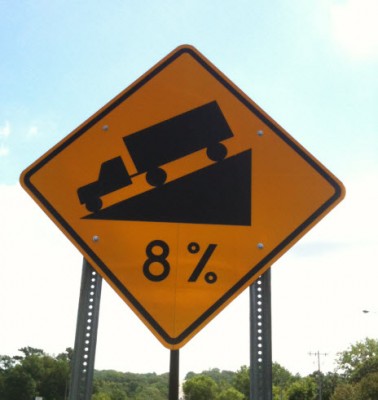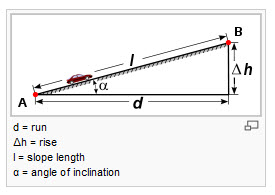
How steep is a 4% grade? 8%? Over 10%?
How do I effectively explain % of grade to my class?
What are the feelings I would experience climbing different % grades on a bicycle?
And finally, how do I effectively communicate that feeling to my class?
Every July we hear commentators Phil Liggett, Paul Sherwin and Bob Roll discuss how the Tour de France is won or lost in the mountains. Just winning one of the popular climbs; Alpe d'Huez, Mont Ventoux, Col du Tourmalet or others can be the highlight of any cyclists career. But when Liggett explains that Alpe d'Huez has an average grade of 8% what exactly does that mean? Based on context, we can assume that this is a very difficult climb... but how difficult? What does it feel like to ride with the professional Peloton as everyone powers up a long climb at 8% grade?
So with the Tour only a month away and many Instructors and students riding outdoors, I felt you might benefit from some cliff notes on Grade and Slope. If you are reading this outside of North America, the concepts that I'm going to present are the same, but how they are noted on street signs varies from country to country.
Simply put, % Grade is gain in elevation (what's called the Rise), over a horizontal distance (the Run) - "typically" 100 feet or meters. The actual distance traveled is the Slope length which is slightly longer than the Run - it's that A²+B²=C² Pythagorean theorem thing you grew to love in highschool 🙂
So...
A 5% grade = a 5' increase in elevation in 100' of horizontal travel.

Image from Wikipedia
So you don't confuse the engineer's in your class, be careful not to mix up % of grade and the degrees of angle. They're completely different and roads aren't measured in °. If you feel it would be helpful to your students, you may want to comment that a road at 45° (as if that would be possible) would have a 100% grade, i.e. 100' forward @ 100' up.
Wikipedia has an informative page on Grade / Slope if you'd like to learn more.
Alpe d'Huez has an average grade of 8.1% over a run of about 13 km. Click to see the profile. That sounds impressive but it really tells you nothing if you don't understand what it feels like to ride a bicycle up an 8.1% grade. Actually 8.1% is the average. The first kilometer and a half are at over 10%.
If you want to clearly communicate the pain of climbing a 8.1% my suggestion is to find a steep hill, ride up it and experience what it feels like.
So now you may be thinking; "great idea John... but I don't recall seeing the grades marked any of the roads in my neighborhood." My response would be; go out, find one and measure it.
I made the video below for a different project where I recommend that cycling studios measure and mark the road as a helpful guide to outdoor cyclists. In the video I describe the simple process of measuring the grade of one of the local climbs in your town.
If that went by to quickly, you divide the number of vertical inches by 120 (10') which gives you the % grade.
How I communicate % grade in my classes.
Discussions of % grade typically come up when I'm teaching a virtual ride using an Epic Planet DVD or Global Ride's Dirty Dozen DVD, the grade of each climb is listed in the information bar at the bottom of the screen and I'll use it to help explain the intensity of each effort. I start by explaining that, although it doesn't sound like much, 4% is a serious climb that will have most of us at Threshold HR or Power FTP if it's of any length. I go on to explain that (at least where I live) most roads or highways rarely exceed 4%.
I'll reference local roads, that I understand the % grade, to my class - my apologies to those of you in flat lands of Iowa or Florida, you're on your own. Some of these roads, on established cycling routes, have steeper grades that I have measured. I'll talk about them by name; "Fox Road Turn" 8%, "Carver Wall" 12% and "Eden Prairie Road" 13.5% as a way to appeal to my cyclists who have experienced these climbs for real.
Other examples:
- 5% has you in your small chain ring (the sprocket in the front) and you need to manage (limit) your effort so as not to blow up!
- 8% and you're wishing you had a smaller gear and it's everything you can do to ride in a straight line. It's also everything you can do keep your pedal stroke smooth. Time here is short with your HR way over VT2 - Threshold.
- 10% is the limit of most recreational cyclists, if the climb is longer than a block or two. Smallest gear, out of the saddle and HR is as close to maximum as you can tolerate.
- 15% or more and you get off and walk 🙁
Once you've measured and ridden a climb with known grade, my guess is you're going to have a new appreciation for how truly difficult those famous climbs in the Tour de France really are and a new respect for the professional cyclists who climb them.
You can find the profiles of every climb, in every major Tour, along with 33,773 others at http://www.climbbybike.com/
Do you have any tough climbs near you?
Originally posted 2012-06-06 11:45:22.
- Eagles pedaling through the air metaphor - April 21, 2024
- ICI Podcast 238 Meet Nerd Fitness Creator Steve Kamb - April 6, 2024
- ICI/PRO Podcast #113 Explosive Power pt 3 – Video PROfile with Tom Scotto from Stage 5 Cycling - March 31, 2024

anyone interested in experiencing some tough climbs check out the Hilly 100 here in the flat midwest of Indiana located in the bloomington area.
Life Time Fitness just had their Hillfest 100 June 2nd. Located in Western Wisconsin, they advertise the ride as “Uphill – Both Ways” 🙂 The 200k route has 8,000 ft of climbing! http://www.lthillfest.com/
I thank you for this info, John.
I’m always a bit confused about how hard a *real* hill should feel. You know I’m a newbie to outdoor riding and don’t have any sort of intuitive “feel” for what I’m doing (mainly due to the fact that there are cars, potholes, pedestrians, critters etc. out on *real* roads)
I found a website a while back (maybe called mapmyride or mapmyrun) where you could feed in your location and, lo, up came a map of your area and you could scroll over roads and get a % grade.
This might sound a bit daft…..but I really didn’t know that a 6 or 7 % grade was actually supposed to feel so hard. Do you think that’s the reason my husband keeps asking me why I can’t slow down a bit so he can keep up (him with the triple and me with the compact, BTW)
I feel like a Performance Machine just for reading this entry!!?!
Vivienne
You have the Power Vivienne – now you and your partner need to both be on a Tandem to let it all out.
Hi all, no problem with us here in sunny Colorado, at the base of Independence Pass (4000 feet in 16 miles) plus lots of other fun climbs….we climb all the big passes in class, and whoop butt, cause we do them all in an hour…:)